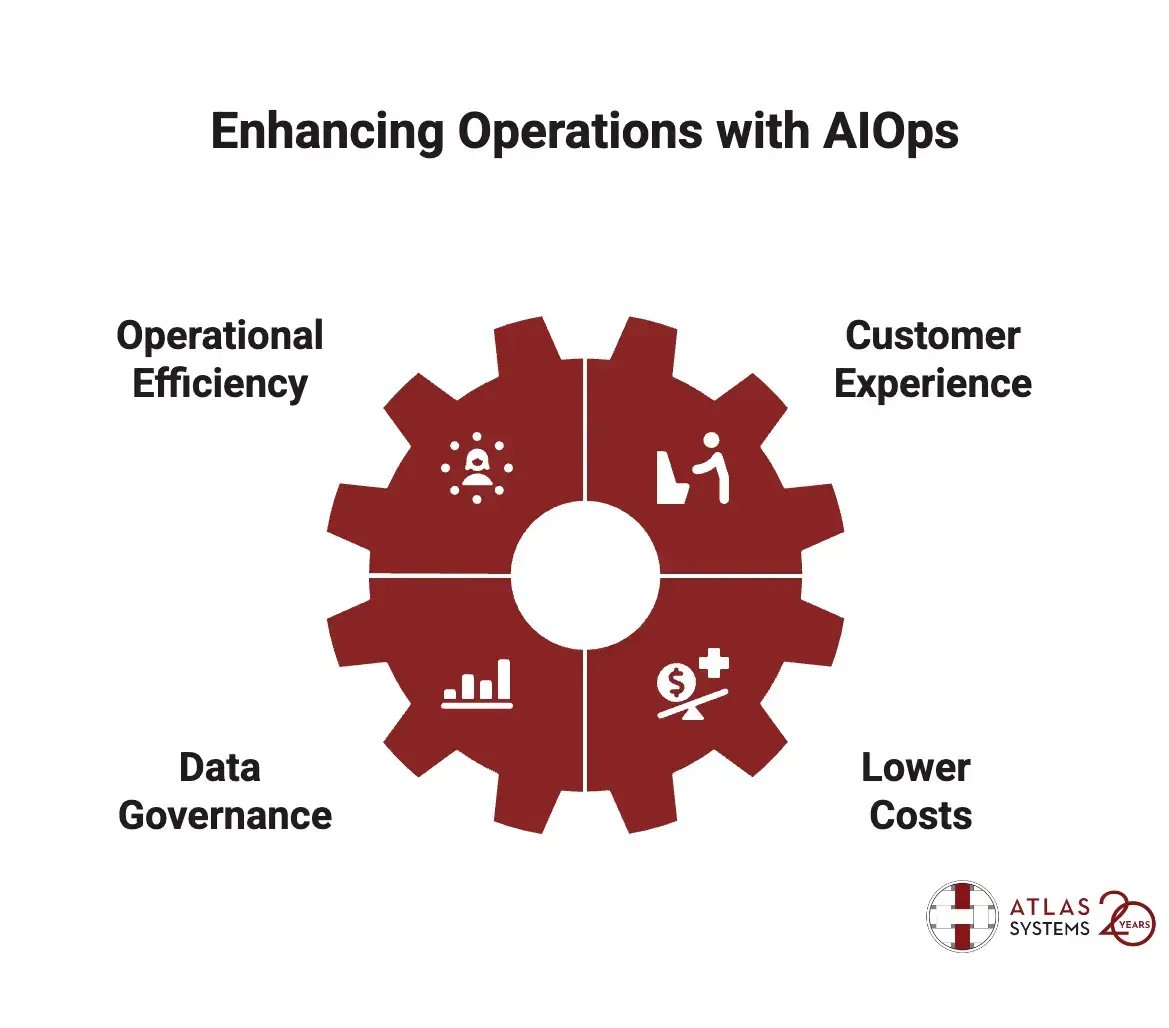Atlas Systems Named a Representative Vendor in 2025 Gartner® Market Guide for TPRM Technology Solutions → Read More

The Growing Impact of AIOps in Financial Services

4 min read | Last Updated: 26 Aug, 2025
It has been called ‘The next big thing in IT operations’ - and AIOps is proving to be that rare case of hyperbole actually meeting reality. Gartner coined the term ‘AIOps’ in 2017 to indicate a combination of AI and operations or Ops. It refers to the way data within an IT environment is managed by an IT team, specifically with the utilization of machine learning and deep learning tools.
AIOps platforms leverage big data, collecting a variety of data from various IT operations tools and devices in order to automatically spot and react to issues in real-time while still providing traditional historical analytics. Few industries use information technology as richly as banking and financial services - and AIOps can help it in a multitude of ways, including operational efficiency, increasing optimization, improving the customer experience, helping fight fraud, and bolstering Know Your Customer initiatives.
Financial services companies are unique in that they utilize traditional systems, like on-premises mainframes and distributed systems, with a complex set of modern dynamic technologies, like containers, cloud delivery models, virtual machines, open-source software, and much, much more. There is probably no industry that combines old technology with new tools quite the way the finance industry does and AIOps is one of the newest – and most important – entrants into the field.
AIOps: Key Trends to Watch in 2024 and Beyond
Driving Operational Efficiency with AIOps

1. Operational Efficiency
AIOps can augment or even replace a variety of current IT operations processes. AIOps builds upon Robotic Process Automation (RPA) and Automation of IT processes (ITPA), combining big data with AI and machine learning. With AI capable of not only independently diagnosing several root cause issues but also understanding those problems holistically, the burden for data teams to understand the source of all their problems is diminished.
The need to painstakingly sort through data logs is also greatly reduced. AIOPs automation can provide notifications for specific system failures, as well as provide answers to technical problems not only in a backward- and forward-looking way, but also in a self-healing way. read more
AIOps can provide a dynamic baseline that defines the normal behavior of an app or a service, then creates and constantly tracks dynamic operational thresholds to ensure everything is running as smoothly and efficiently as possible. Workflow automation provides for the efficient execution of predetermined workflows. AIOps breaks down data silos, making data throughout the organization much more visible, trustworthy, analyzable, and ultimately, more useful.
2. Customer Experience
According to a report, 74% of bank operations leaders say customer experience is their top strategic priority. Today, the quality of a customer’s experience is completely shaped by the digital channels that customers interact with daily. Banks must deliver a seamless experience across all customer channels while also connecting with the customer on a highly personal level, whether the connection occurs online, on a mobile device, at an ATM, or in a branch.
Fulfilling customer expectations is the prime goal of finance companies. In a recent survey, banking executives found that “customer expectations” rated highest and were driving disruption in the finance industry. Bank customers need real-time access to their accounts and balances. Fraud departments need both real-time access to transaction data so they can build powerful predictive models as well as proactive solutions that can spot outliers that might just be the signal of nefarious activity.
AIOps helps in both these cases because it provides end-to-end visibility of a company’s applications and infrastructure. It reduces noise in the data, breaks down data silos, and simplifies root cause analysis throughout the operation. All-in-all, AIOps provides a seamless customer experience that banking customers might not notice, but that, in itself is something to be noted.
3. Data Governance
AIOps tools can profile and catalog data automatically. AIOps can assess a company’s data sources based on the six dimensions of data quality — accuracy, completeness, consistency, timeliness, uniqueness, and validity. A “trust index” can be created and data that falls outside a specific set of indicators will trigger alerts that inform necessary parties of issues or approaching issues.
Once the incoming data assets are identified, documented, and trusted, it is time to organize them for massive consumption by an extended network of data users within an organization and AIOps facilitates just this.
4. Lower Costs
Because AIOps can handle many of the common and repetitive tasks and issues that a normal service desk must take care of, labor costs can be reduced. Standard problems like lost passwords, log in issues, or company-wide system issues can be handled by an AIOps system, reducing the need for live customer service reps. AIOps can relieve IT personnel of minor everyday problems, leaving them free to handle only the challenging issues, ones that require creative thought.
A movement to AIOps can create substantial savings by automating customer service queries. It is considerably cheaper for a financial institution to handle customer requests and customer complaints on an app or online rather than in person. AIOps simplifies the process of getting data into the hands of a customer, making it more likely they will not need a live customer service rep for help.
Conclusion
For finance companies, AIOps helps IT automate monitoring at scale. Every day, the volume, variety, veracity, and velocity of data that needs to be managed, cleansed, documented, correlated, and analyzed increases dramatically. AIOps separates signal from noise while filtering out real incidents that demand attention from insignificant ones that can be ignored. Governance becomes a breeze and ROI even becomes measurable.
.png?width=869&height=597&name=image%20(5).png)

.png?width=300&height=175&name=Rectangle%2034624433%20(2).png)







.png?width=645&height=667&name=Widgets%20(2).png)


